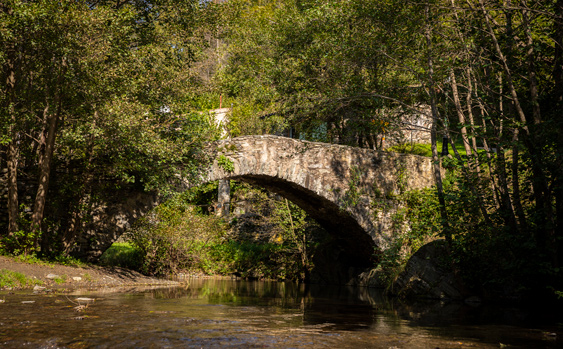Molló is a border municipality in Vall de Camprodon at the headwaters of the River Ritort and the gateway to Capçaleres del Ter i del Freser Natural Park. Formed by the villages of Molló and Espinavell and the hamlets of Can Solà, Fabert, Favars, Ginestosa, Els Grells, Moixons and El Riberal, it is marked by a history of important events. The time has come to discover them all.
The municipality of Molló
-
Origins
The first written document in which the name of Molló (Mollione) appears dates back to the 10th century, specifically the year 936, although there are signs of a previous, probably Celtic, settlement. In 1659, as a result of the Treaty of the Pyrenees, it became a border municipality. For this reason, it proved essential in the exile of refugees from the Spanish Civil War (1939), which today is commemorated by the Camí de la Retirada path.
-
Did you know that…?
Molló was named after a type of stone that was used to mark the limits of territorial divisions or borders. Boundary markers delimiting the territories of Catalonia and France can still be found in the area.
-

Santa Cecília
This church, which has been declared a cultural asset of national interest and was constructed from the 10th to the 12th centuries, is an important example of Pyrenean Romanesque architecture. It is noteworthy due to its nave, which is headed to the east by a semi-circular apse, and its Lombard-style bell tower.
-

Capella de Sant Sebastià
Located on the street of the same name, it was built in the 18th century in gratitude to Saint Sebastian, the Roman martyr, for sparing the municipality from the plagues that were devastating Europe.
-

Bridge of El Molí de Can Fumat
The hamlet of El Riberal is home to the Romanesque bridge of El Molí de Can Fumet, an idyllic crossing over the River Ritort. You can get there by following one of the Itinerànnia network hiking trails.
-

Retirada path
In the final stages of the Spanish Civil War, in January and February 1939, 100,000 people crossed the Pyrenees on this “path of retreat” between Vall de Camprodon and Vallespir, and Prats de Molló became a makeshift refugee camp. Programme of guided walks at www.mollo.cat/retirada.
-

Col d'Ares
Climb up to the Col d’Ares mountain pass, the border point established in 1659 by the Treaty of the Pyrenees. On 23 June, the Canigó Flame is lit there and carried by torches to light bonfires throughout Catalonia.
-

Espinavell
This village forms part of the headwaters of the River Ritort. The church of Mare de Déu de les Neus (Our Lady of the Snow), built in the 17th century, lies at its heart. From it four streets run in the directions of the cardinal points.
-

Horse Fair
Espinavell’s annual horse fair takes place on 13 October. More than 300 horses are offered for sale at this traditional event. An artisanal products fair is also held.
-

MOLLÓ PARC
The Animal Park of the Pyrenees! Discover the fauna of the Eastern Pyrenees in this open-air park. And also enjoy its adventure park! For further information visit: www.molloparc.com.
More information
-

Molló Town Hall
MORE INFO
Resources
Other towns
-

Llanars
Thanks to its location at the opening of the valley, every corner of Llanars is filled with light. As it...
MORE INFO -

Planoles
Nestled in a privileged location in the Pyrenean Rigat valley lies Planoles, a charming little village which invites you to...
MORE INFO -

Vilallonga de Ter
Visitors to the picturesque town of Vilallonga del Ter are captivated by the mystique of its narrow streets with pleasant...
MORE INFO







